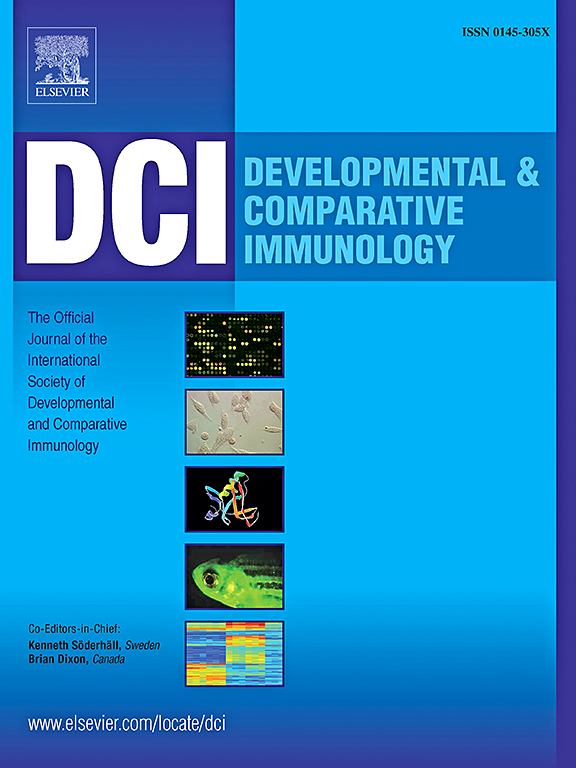脂素B4和脂钙蛋白在肠道微生物共生诱导的昆虫免疫启动中起重要作用。
IF 2.7
3区 农林科学
Q1 FISHERIES
引用次数: 0
摘要
寄主白菜具有枯草芽孢杆菌内生菌,可诱导小菜蛾免疫启动。相反,在无菌条件下饲养的幼虫失去了喂养细菌的机会,并且对各种病原体高度敏感。在无菌幼虫中添加枯草芽孢杆菌可显著恢复免疫应答,提高病原体感染后的存活率。试图在因子(s)决定在18载脂蛋白D(无足的)基因确定为lipocalin候选人p .蛾ApoD1表达式的功能与b subtilis-induced试图。此外,通过LC-MS/MS分析免疫诱导的幼虫体内脂毒素,检测到LXB4,但未检测到LXA4。LXB4的滴度显著高于无菌条件下饲养的幼虫。值得注意的是,LXB4单独足以诱导显著的免疫应答。为了支持昆虫脂素的生物合成,本研究鉴定了一种类似脂氧化酶的过氧化物酶基因HemP2。在免疫诱导的幼虫中诱导其表达。然而,它的抑制抑制了LXB4在免疫启动条件下的产生。为了解释脂钙素/脂素在肠道共体中的上调,我们分析了Toll和IMD免疫信号通路。在枯草芽孢杆菌诱导的免疫启动条件下,小菜蛾幼虫肠道中ApoD1和HemP2的表达上调是通过IMD而不是Toll免疫信号通路介导的。这项研究强调了包括枯草芽孢杆菌在内的共生肠道微生物在IMD免疫信号通路中通过昆虫脂素-脂钙蛋白复合物驱动免疫启动的潜在作用。本文章由计算机程序翻译,如有差异,请以英文原文为准。
Lipoxin B4 and lipocalin play a crucial role in insect immune-priming induced by a gut microbial commensal
Host cabbage possesses an endophyte, Bacillus subtilis, which induced immune-priming of the diamondback moth, Plutella xylostella. In contrast, larvae raised under axenic conditions lost the chance to feed the bacteria and were highly susceptible to various pathogens. Addition of B. subtilis to axenic larvae significantly restored immune responses and enhanced survival rates following pathogen infections. The immune-priming factor(s) was determined among 18 apolipoprotein D (ApoD) genes identified as lipocalin candidates in P. xylostella, in which ApoD1 expression was functionally linked with B. subtilis-induced immune-priming. In addition, lipoxins were analyzed in immune-primed larvae via LC-MS/MS, in which LXB4 was detected, but not LXA4. The LXB4 titer was significantly higher than that that in the larvae reared under axenic conditions. Notably, LXB4 alone sufficiently induced significant immune responses. To support lipoxin biosynthesis in insects, this study identified a lipoxygenase-like peroxidase gene, HemP2. Its expression was induced in the immune-primed larvae. However, its suppression prevented LXB4 production under the immune-priming conditions. To explain the up-regulations of lipocalin/lipoxin by the gut commensal, Toll and IMD immune signaling pathways were analyzed. The up-regulation of ApoD1 and HemP2 expressions was mediated through the IMD, but not the Toll, immune signaling pathway in the larval gut of P. xylostella under B. subtilis-induced immune-priming conditions. This study highlights the potential role of commensal gut microbes including B. subtilis in driving immune-priming via an insect lipoxin-lipocalin complex through the IMD immune signaling pathway.
求助全文
通过发布文献求助,成功后即可免费获取论文全文。
去求助
来源期刊
CiteScore
6.20
自引率
6.90%
发文量
206
审稿时长
49 days
期刊介绍:
Developmental and Comparative Immunology (DCI) is an international journal that publishes articles describing original research in all areas of immunology, including comparative aspects of immunity and the evolution and development of the immune system. Manuscripts describing studies of immune systems in both vertebrates and invertebrates are welcome. All levels of immunological investigations are appropriate: organismal, cellular, biochemical and molecular genetics, extending to such fields as aging of the immune system, interaction between the immune and neuroendocrine system and intestinal immunity.

 求助内容:
求助内容: 应助结果提醒方式:
应助结果提醒方式:


